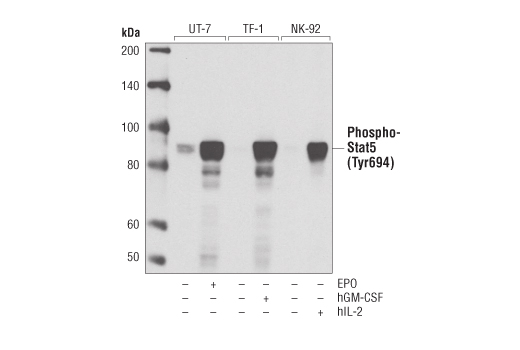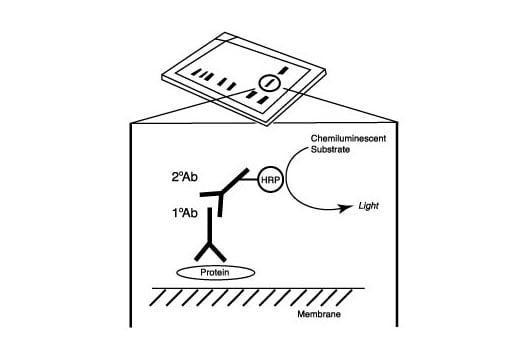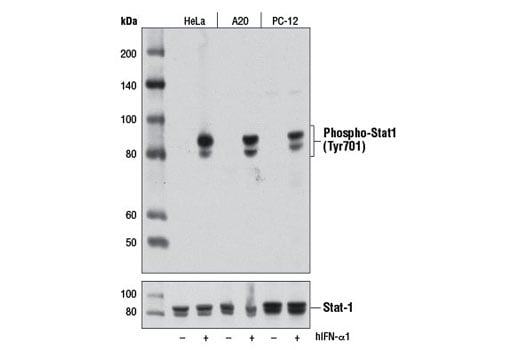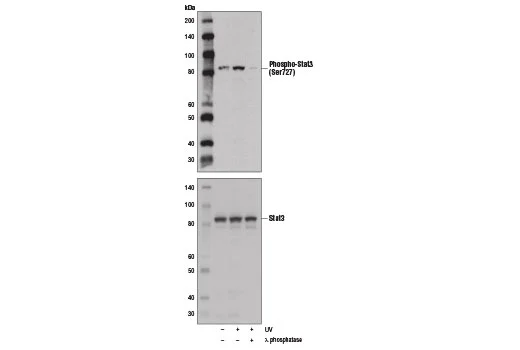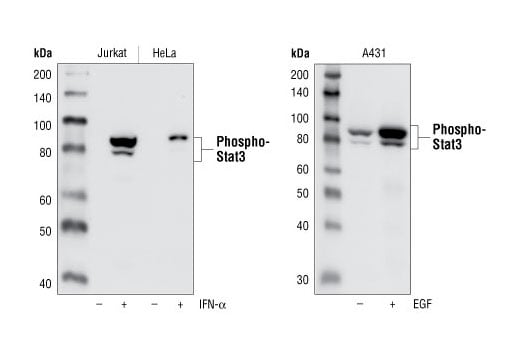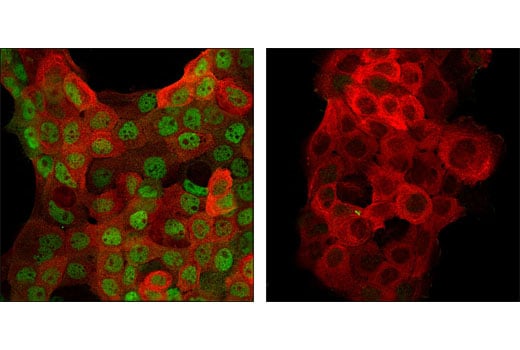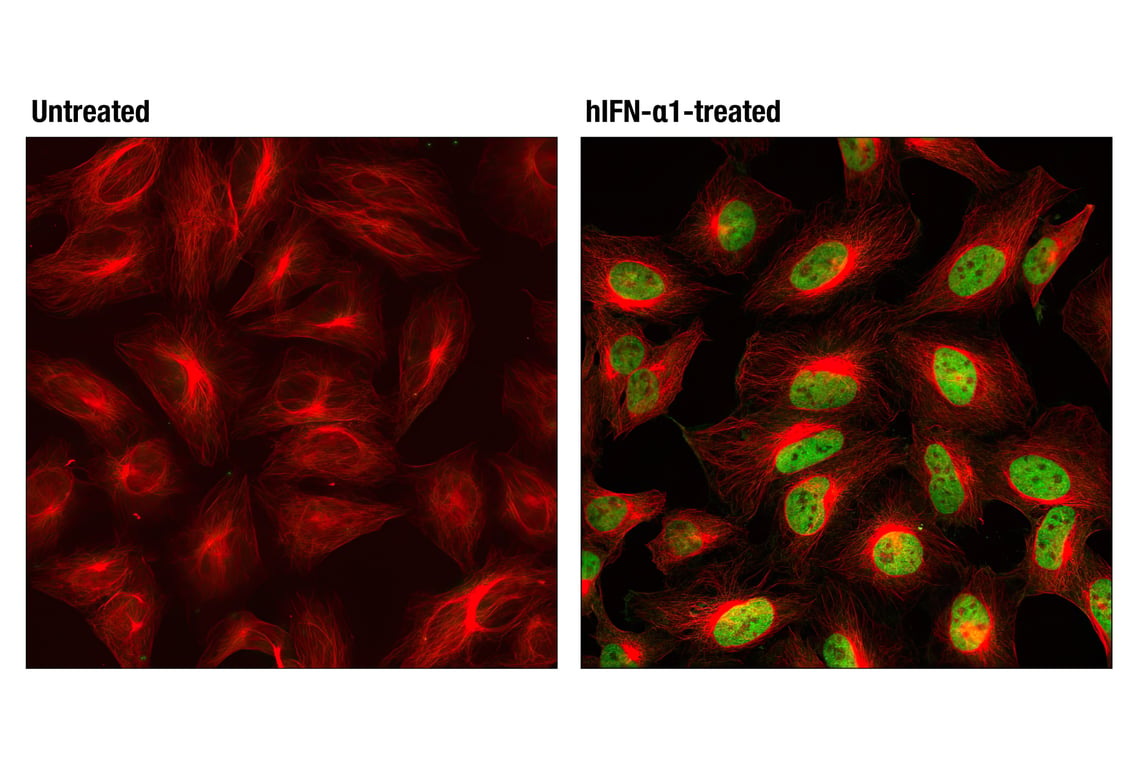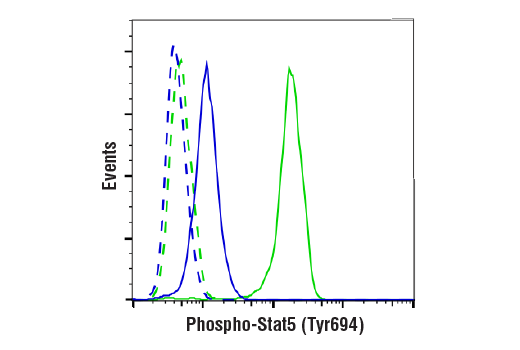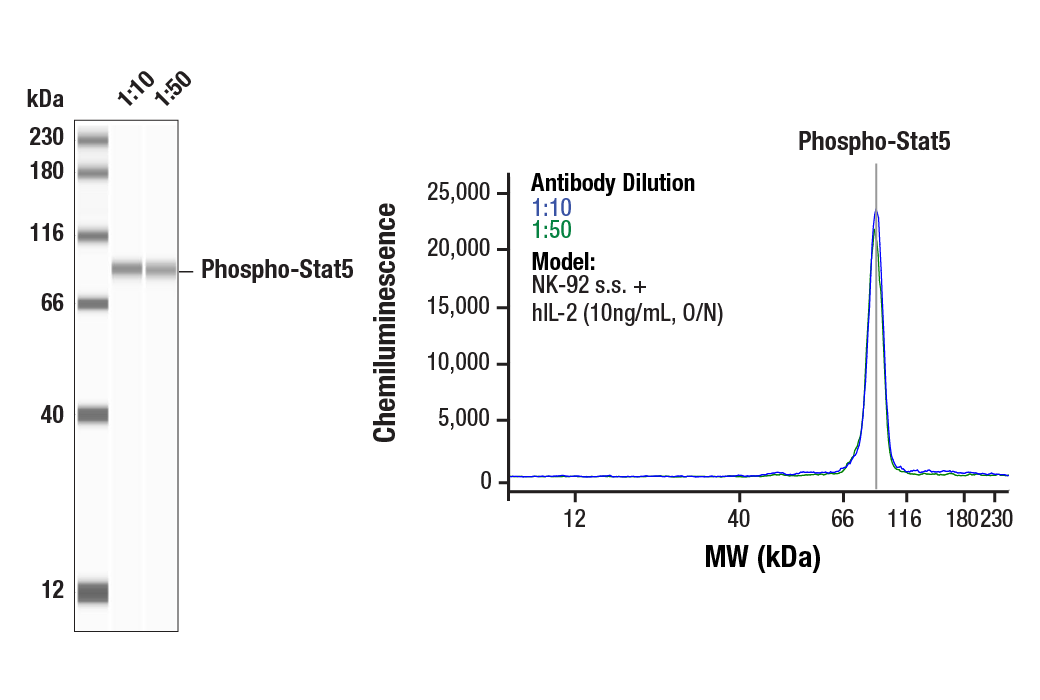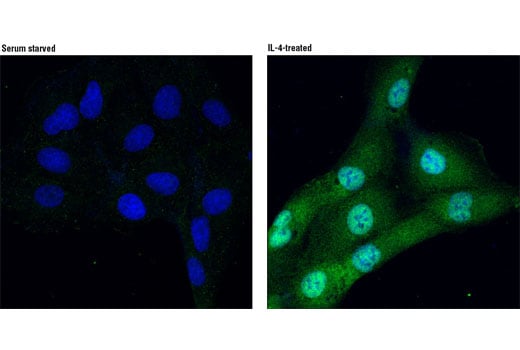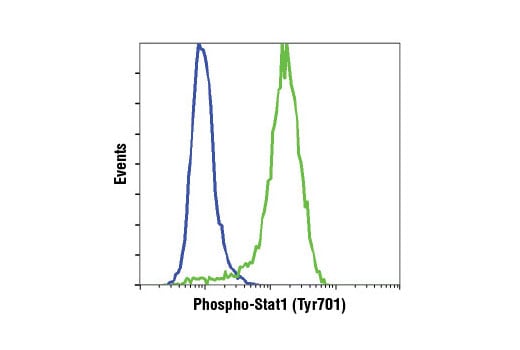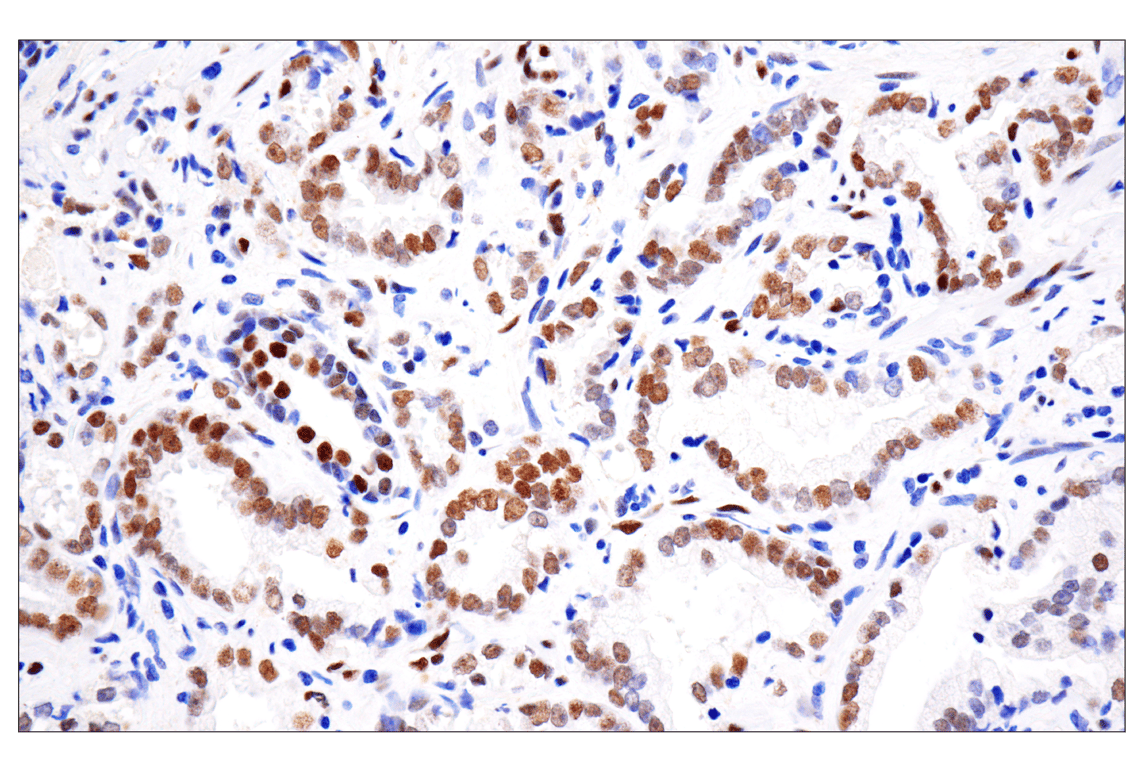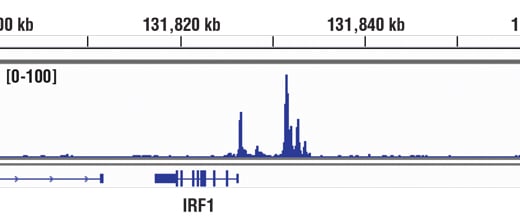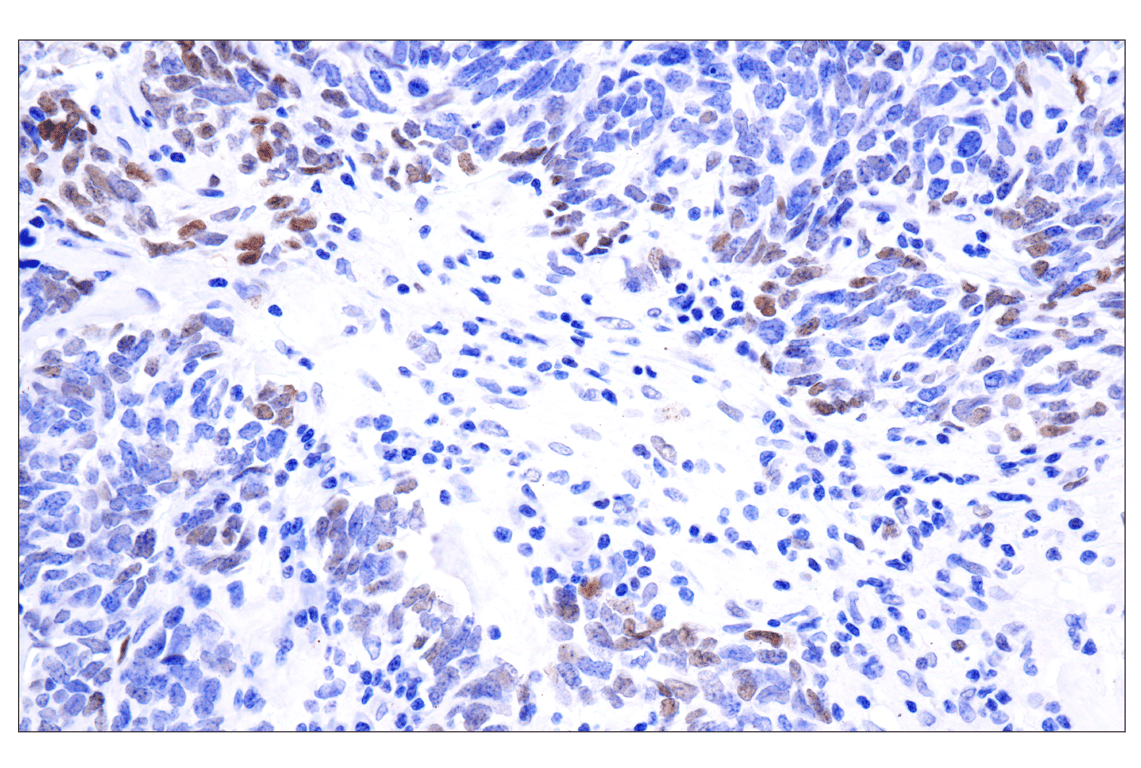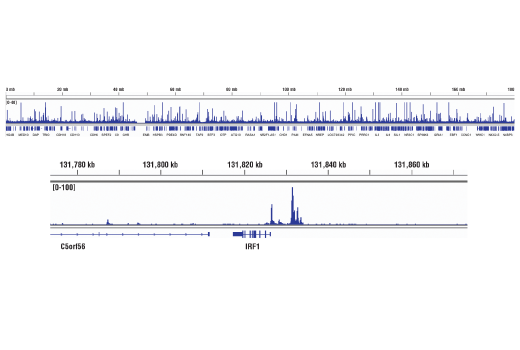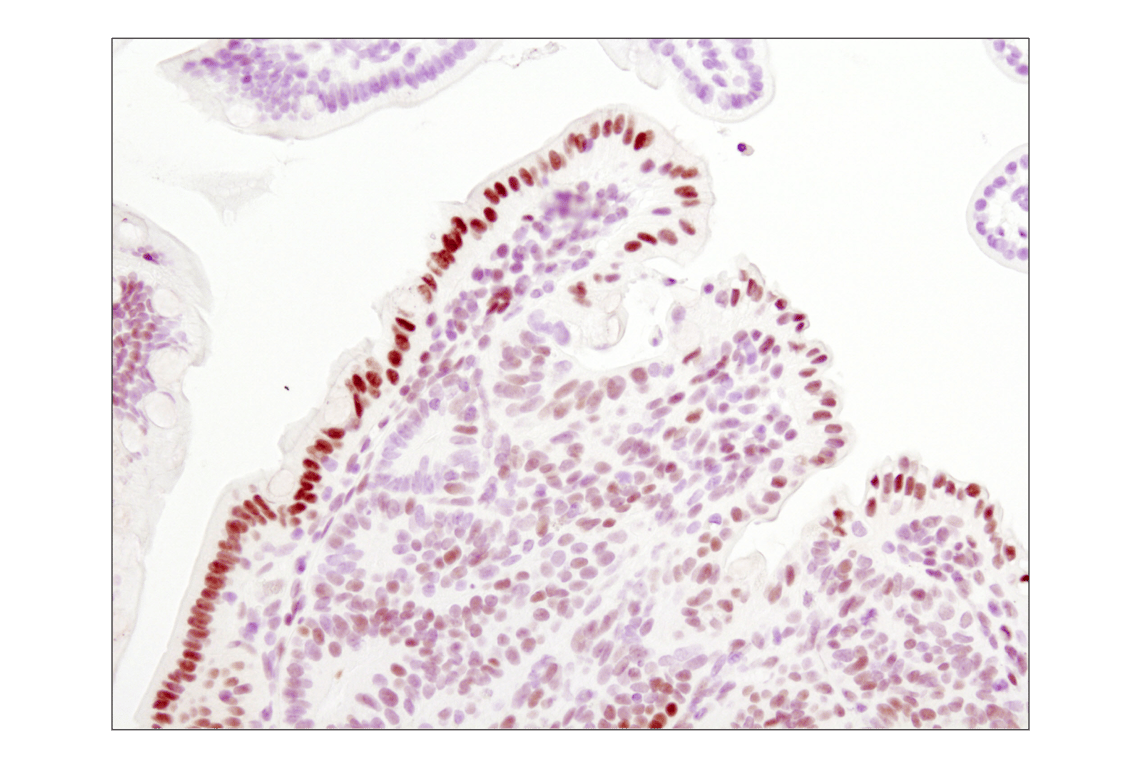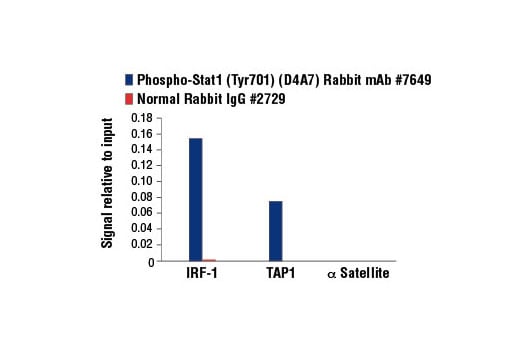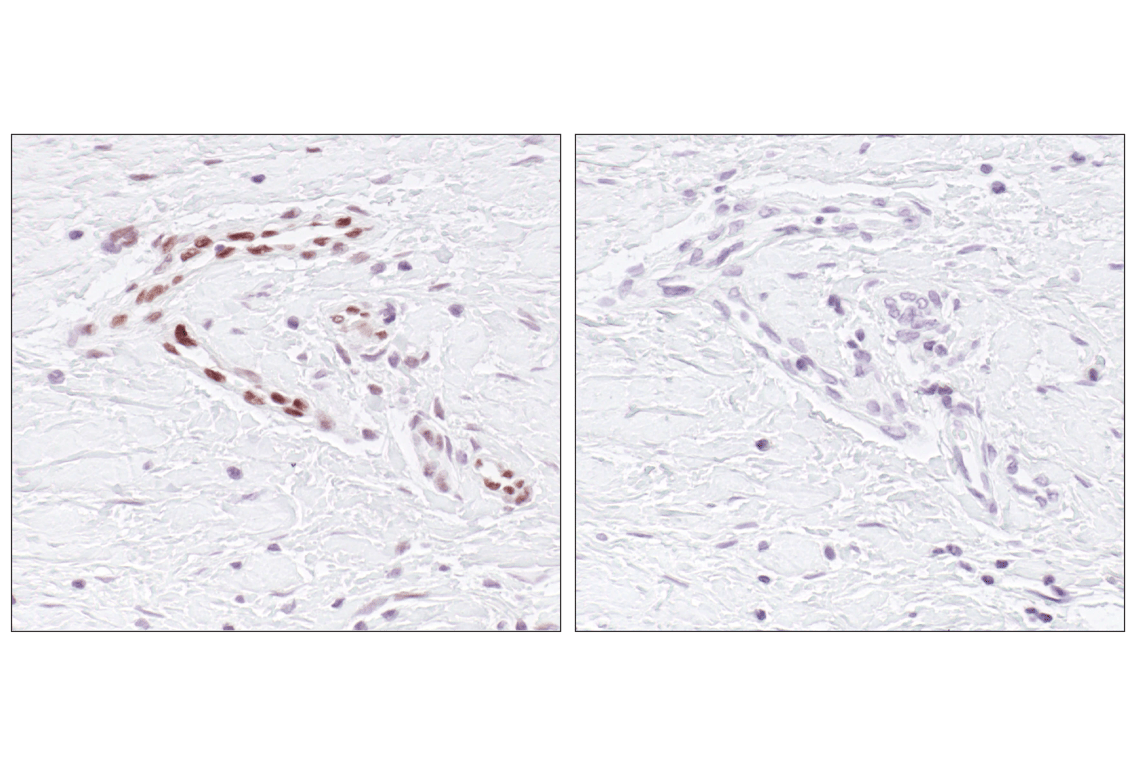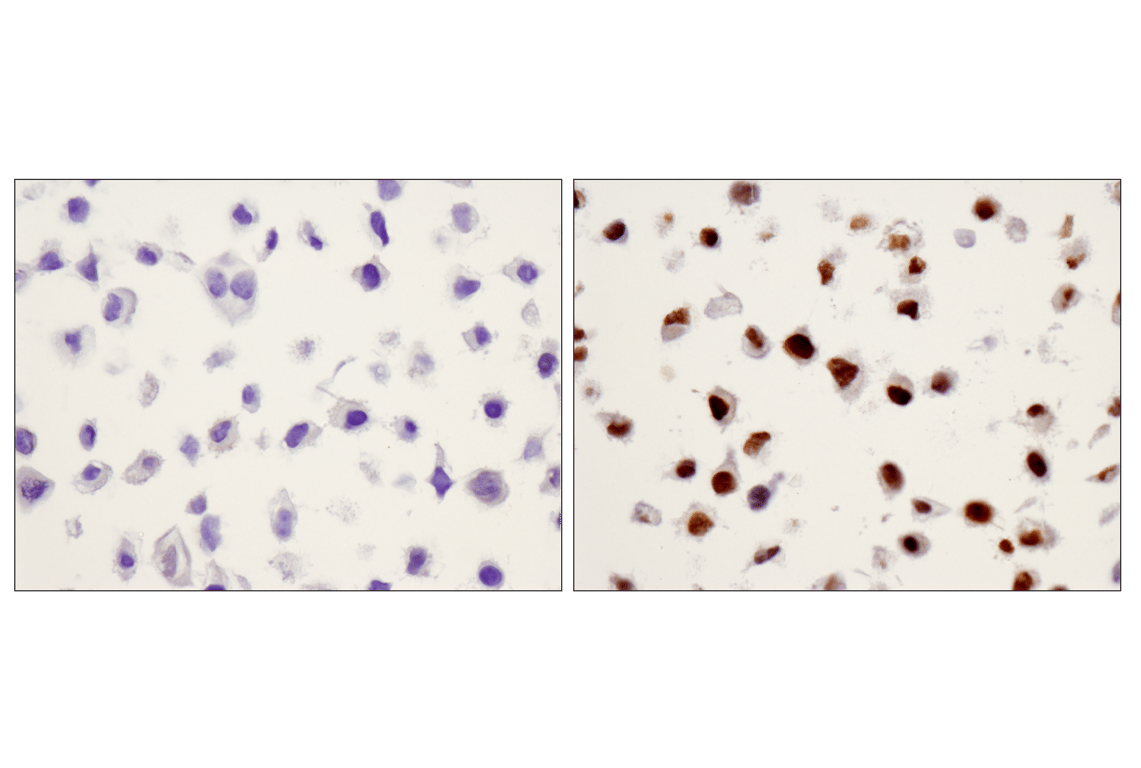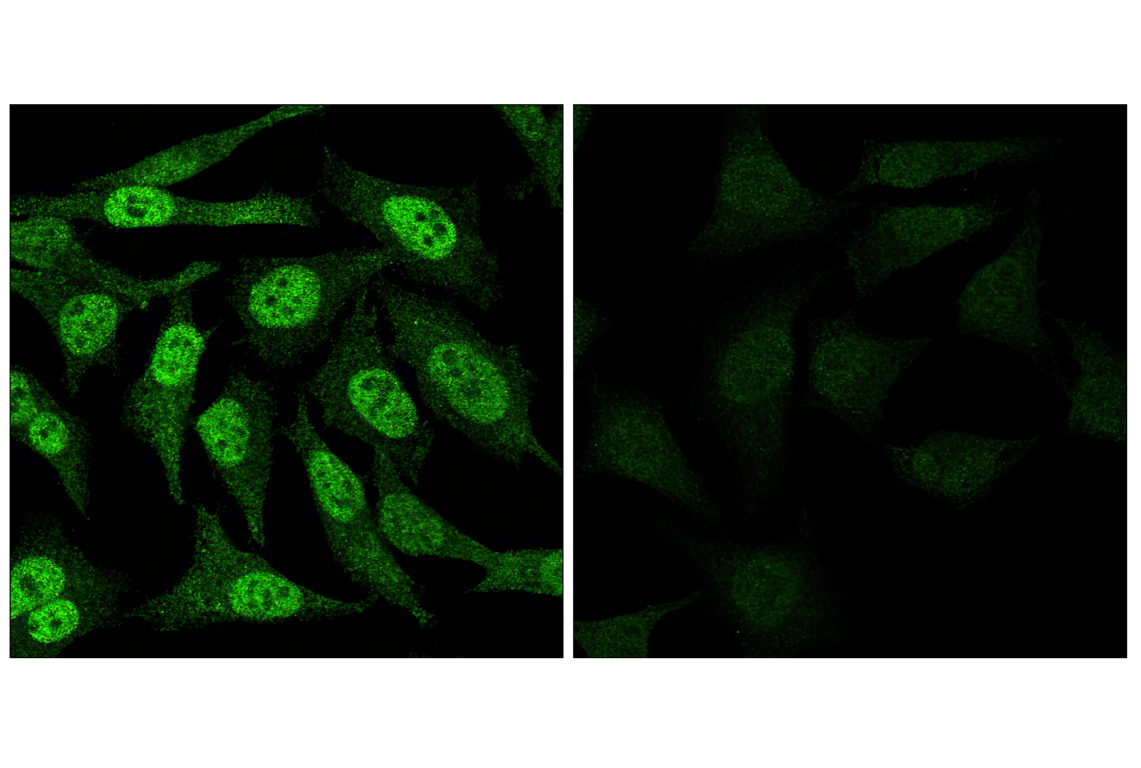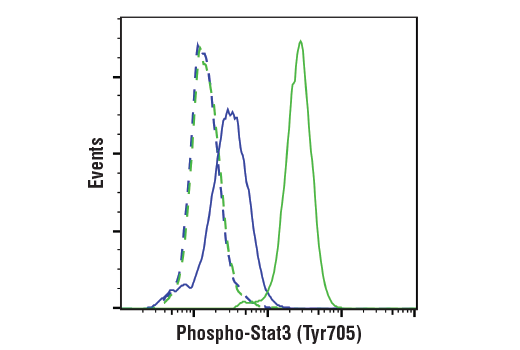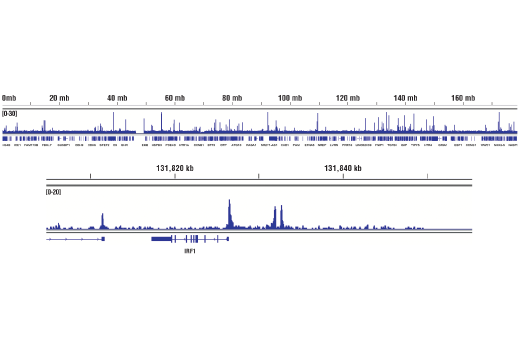 全部商品分类
全部商品分类



 下载产品说明书
下载产品说明书 下载SDS
下载SDS 用小程序,查商品更便捷
用小程序,查商品更便捷


 收藏
收藏
 对比
对比 咨询
咨询
The Phospho-Stat Pathway Sampler Kit provides an economical means to evaluate the activation status of Stat molecules, including the phosphorylation of Stat1 at Tyr701, Stat2 at Tyr690, Stat3 at Tyr705/Ser727, Stat5 at Tyr694 and Stat6 at Tyr641. The kit includes enough primary and secondary antibody to perform two Western blot experiments.






参考图片
Simple Western™ analysis of lysates (0.1 mg/mL) from serum-starved HeLa cells treated with IFN-alpha (100 ng/mL, 5 min) using Phospho-Stat3 (Tyr705) (D3A7) XP® Rabbit mAb #9145. The virtual lane view (left) shows a single target band (as indicated) at 1:10 and 1:50 dilutions of primary antibody. The corresponding electropherogram view (right) plots chemiluminescence by molecular weight along the capillary at 1:10 (blue line) and 1:50 (green line) dilutions of primary antibody. This experiment was performed under reducing conditions on the Jess™ Simple Western instrument from ProteinSimple, a BioTechne brand, using the 12-230 kDa separation module.
Western blot analysis of extracts from UT-7 cells, untreated or treated with erythropoietin (EPO; 3 units/ml for 5 min), TF-1 cells, untreated or treated with Human Granulocyte Macrophage Colony Stimulating Factor #8922 (hGM-CSF; 100 ng/ml for 10 min), and NK-92 cells, untreated or treated with Human Interleukin-2 #8907 (hIL-2; 100 ng/ml for 10 min), using Phospho-Stat5 (Tyr694) (D47E7) XP® Rabbit mAb.
Western blot analysis of extracts from HeLa cells, untreated or IFN-α-treated (100 ng/ml, 15 minutes), using Stat2 Antibody (upper) or Phospho-Stat2 (Tyr690) Antibody (lower).
After the primary antibody is bound to the target protein, a complex with HRP-linked secondary antibody is formed. The LumiGLO® is added and emits light during enzyme catalyzed decomposition.
Western blot analysis of extracts from HeLa, A20, and PC-12 cells, untreated or treated with Human Interferon-α1 (hIFN-α1) #8927 (10 ng/ml, 30 min), using Phospho-Stat1 (Tyr701) (D4A7) Rabbit mAb (upper) or Stat1 Antibody #9172 (lower).
Western blot analysis of extracts from A172 cells, untreated (-) or UV-treated (100 mJ, 30 min; +) with or without λ phosphatase (+), using Phospho-Stat3 (Ser727) Antibody (upper) and Stat3 (79D7) Rabbit mAb #4904 (lower).
Western blot analysis of extracts from IFN-alpha treated Jurkat cells and HeLa cells (left), as well as EGF treated A431 cells (right), using Phospho-Stat3 (Tyr705) (D3A7) XP® Rabbit mAb. Note that the basal phospho-Stat3 in A431 is detected by the antibody.
Western blot analysis of extracts from Daudi cells, treated with IL-4 (100 ng/ml) for the indicated times using Phospho-Stat6 (Tyr641) Antibody (upper) or Stat6 antibody (lower).
Confocal immunofluorescent analysis of A-431 cells, EGF-treated (left) or untreated (right), using Phospho-Stat5 (Tyr694) XP®(D47E7) Rabbit mAb (green) and Pan-Keratin (C11) Mouse mAb #4545 (red).
Confocal immunofluorescent analysis of HeLa cells, untreated (left) or treated with hIFN-α1 #8927 (100 ng/mL, 30 min; right), using Phospho-Stat1 (Tyr701) (D4A7) Rabbit mAb (green) and β-Tubulin (9F3) Rabbit mAb (Alexa Fluor® 555 Conjugate) #2116 (red).
Flow cytometric analysis of TF-1 cells, untreated (blue, low) or treated with hGM-CSF #8922 (50 ng/ml, 15 min; green, positive) using Phospho-Stat5 (Tyr694) (D47E7) XP® Rabbit mAb (solid lines) or concentration-matched Rabbit (DA1E) mAb IgG XP® Isotype Control #3900 (dashed lines). Anti-rabbit IgG (H+L), F(ab')2 Fragment (Alexa Fluor® 488 Conjugate) #4412 was used as a secondary antibody.
Simple Western™ analysis of lysates (1 mg/mL) from serum-starved NK-92 cells treated with hIL-2 (10 ng/mL, O/N) using Phospho-Stat5 (Tyr694) (D47E7) XP® Rabbit mAb #4322. The virtual lane view (left) shows the target band (as indicated) at 1:10 and 1:50 dilutions of primary antibody. The corresponding electropherogram view (right) plots chemiluminescence by molecular weight along the capillary at 1:10 (blue line) and 1:50 (green line) dilutions of primary antibody. This experiment was performed under reducing conditions on the Jess™ Simple Western instrument from ProteinSimple, a BioTechne brand, using the 12-230 kDa separation module.
Immunoprecipitation of phospho-Stat3 (Tyr705) from U266 extracts treated with human IFN-α (50 ng/ml, 15 min). Lane 1 is 10% input, lane 2 is Rabbit (DA1E) mAb IgG XP® Isotype Control #3900, and lane 3 is Phospho-Stat3 (Tyr705) (D3A7) XP® Rabbit mAb. Western blot analysis was performed using Phospho-Stat3 (Tyr705) (3E2) Mouse mAb #9138. Anti-mouse IgG, HRP-linked Antibody #7076 was used as a secondary antibody.
Confocal immunofluorescent analysis of ACHN cells serum-starved (left) or IL-4-treated (right) using Phospho-Stat6 (Tyr641) Antibody (green). Blue pseudocolor= DRAQ5® #4084 (fluorescent DNA dye).
Flow cytometric analysis of Jurkat cells, untreated (blue) or treated with hIFN-α1 #8927 (green), using Phospho-Stat1 (Tyr701) (D4A7) Rabbit mAb.
Immunohistochemical analysis of paraffin-embedded human prostate adenocarcinoma using Phospho-Stat3 (Tyr705) (D3A7) XP® Rabbit mAb performed on the Leica® BOND™ Rx.
Chromatin immunoprecipitations were performed with cross-linked chromatin from HT-1080 cells treated with IFN-γ (50 ng/ml) for 30 minutes and Phospho-Stat1 (Tyr701) (D4A7) Rabbit mAb, using SimpleChIP® Enzymatic Chromatin IP Kit (Magnetic Beads) #9003. DNA Libraries were prepared using DNA Library Prep Kit for Illumina® (ChIP-seq, CUT&RUN) #56795. The figure shows binding across IRF-1, a known target gene of Phospho-Stat1 (see additional figure containing ChIP-qPCR data). For additional ChIP-seq tracks, please download the product datasheet.
Immunohistochemical analysis of paraffin-embedded human neuroendocrine lung carcinoma using Phospho-Stat3 (Tyr705) (D3A7) XP® Rabbit mAb performed on the Leica® BOND™ Rx.
Chromatin immunoprecipitations were performed with cross-linked chromatin from 4 x 106 HT-1080 cells treated with IFN-γ (50 ng/ml) for 30 minutes and 5 μl of Phospho-Stat1 (Tyr701) (D4A7) Rabbit mAb, using SimpleChIP® Enzymatic Chromatin IP Kit (Magnetic Beads) #9003. DNA Libraries were prepared using DNA Library Prep Kit for Illumina® (ChIP-seq, CUT&RUN) #56795. The figure shows binding across chromosome 5 (upper), including IRF1 (lower), a known target gene of Phospho-Stat1 (see additional figure containing ChIP-qPCR data).
Immunohistochemical analysis of paraffin-embedded Apc (min/+) mouse intestine, using Phosho-Stat3 (Tyr705) (D3A7) XP® Rabbit mAb.
Chromatin immunoprecipitations were performed with cross-linked chromatin from HT-1080 cells treated with IFN-γ (50 ng/ml) for 30 minutes and either Phospho-Stat1 (Tyr701) (D4A7) Rabbit mAb or Normal Rabbit IgG #2729 using SimpleChIP® Enzymatic Chromatin IP Kit (Magnetic Beads) #9003. The enriched DNA was quantified by real-time PCR using human IRF-1 promoter primers, SimpleChIP® Human TAP1 Promoter Primers #5148, and SimpleChIP® Human α Satellite Repeat Primers #4486. The amount of immunoprecipitated DNA in each sample is represented as signal relative to the total amount of input chromatin, which is equivalent to one.
Immunnohistochemical analysis of paraffin-embedded human lung carcinoma, showing nuclear localization, using Phospho-Stat3 (Tyr705) (D3A7) XP® Rabbit mAb.
Immunohistochemical analysis of paraffin embedded human breast carcinoma, specifically endothelial cells, untreated (left) or lambda phosphatase treated (right), using Phospho-Stat3 (Tyr705) (D3A7) XP® Rabbit mAb.
Immunohistochemical analysis using Phospho-Stat3 (Tyr705) (D3A7) XP® Rabbit mAb on SignalSlide® HeLa -/+ IFNa IHC Controls #55861 (paraffin-embedded HeLa cell pellets, untreated (left) or treated with Human Interferon-α1 (hIFN-α1) #8927 (right)).
Confocal immunofluorescent analysis of HeLa cells, IFN-alpha treated (left) or untreated (right), labeled with Phospho-Stat3 (Tyr705) (D3A7) XP® Rabbit mAb (green).
Flow cytometric analysis of U266 cells, untreated (blue) or treated with IFNalpha (50 ng/ml, 15 min; green) using Phospho-Stat3 (Tyr705) (D3A7) XP® Rabbit mAb (solid lines) or concentration matched Rabbit (DA1E) mAb IgG XP® Isotype Control #3900 (dashed lines). Anti-rabbit IgG (H+L), F(ab')2 Fragment (Alexa Fluor® 488 Conjugate) #4412 was used as a secondary antibody.
Chromatin immunoprecipitations were performed with cross-linked chromatin from Hep G2 cells starved overnight and treated with IL-6 (100 ng/ml) for 30 minutes and Phospho-Stat3 (Tyr705) (D3A7) XP® Rabbit mAb, using SimpleChIP® Plus Enzymatic Chromatin IP Kit (Magnetic Beads) #9005. DNA Libraries were prepared using DNA Library Prep Kit for Illumina® (ChIP-seq, CUT&RUN) #56795. The figure shows binding across IRF1, a known target gene of Phospho-Sata3 (see additional figure containing ChIP-qPCR data). For additional ChIP-seq tracks, please download the product datasheet.
Chromatin immunoprecipitations were performed with cross-linked chromatin from HaCaT cells Hep G2 cells starved overnight and treated with IL-6 (100 ng/ml) for 30 minutes and either Phospho-Stat3 (Tyr705) (D3A7) XP® Rabbit mAb or Normal Rabbit IgG #2729 using SimpleChIP® Plus Sonication Chromatin IP Kit #56383. The enriched DNA was quantified by real-time PCR using SimpleChIP® Human c-Fos Promoter Primers #4663, human IRF1 promoter primers, and SimpleChIP® Human α Satellite Repeat Primers #4486. The amount of immunoprecipitated DNA in each sample is represented as signal relative to the total amount of input chromatin, which is equivalent to one.
Chromatin immunoprecipitations were performed with cross-linked chromatin from Hep G2 cells starved overnight and treated with IL-6 (100 ng/ml) for 30 minutes, and either Phospho-Stat3 (Tyr705) (D3A7) XP® Rabbit mAb or of Normal Rabbit IgG #2729 using SimpleChIP® Enzymatic Chromatin IP Kit (Magnetic Beads) #9003. The enriched DNA was quantified by real-time PCR using human IRF-1 promoter primers, SimpleChIP® Human c-Fos Promoter Primers #4663, and SimpleChIP® Human α Satellite Repeat Primers #4486. The amount of immunoprecipitated DNA in each sample is represented as signal relative to the total amount of input chromatin, which is equivalent to one.
Western blot analysis of extracts from HeLa cells, untreated or treated with IFNa (#36000, 100 ng/mL, 5 min) or IFNg (#80385, 100 ng/mL, 30 min); using Phospho-Stat3 (Tyr705) (D3A7) XP® Rabbit mAb #9145 (upper), Stat3 (D3Z2G) Rabbit mAb #12640 (middle), and β-Actin (D6A8) Rabbit mAb #8457 (lower).



